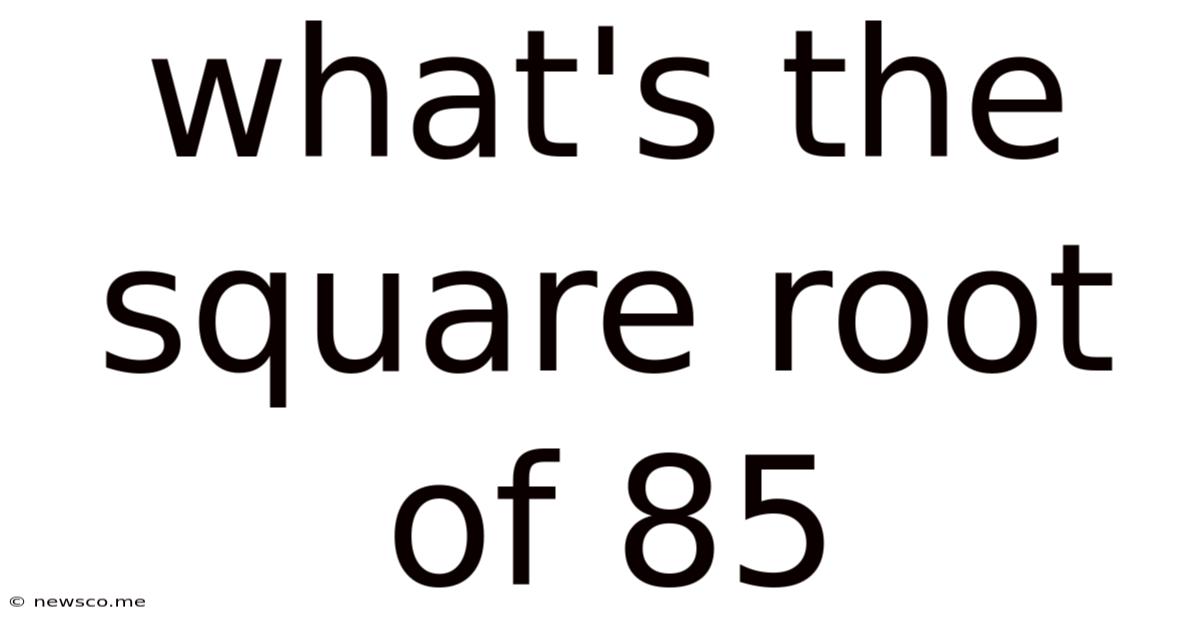What's The Square Root Of 85
News Co
Mar 27, 2025 · 5 min read

Table of Contents
What's the Square Root of 85? A Deep Dive into Square Roots and Approximation Techniques
The question, "What's the square root of 85?" might seem simple at first glance. A quick search on a calculator will give you a decimal approximation. But understanding the concept of square roots, exploring different methods for calculating them, and appreciating the nuances of approximations provides a richer mathematical experience. This article will delve deep into finding the square root of 85, exploring various methods, and discussing the implications of dealing with irrational numbers.
Understanding Square Roots
Before we tackle the square root of 85, let's solidify our understanding of what a square root actually is. The square root of a number, 'x', is a value that, when multiplied by itself, equals 'x'. In simpler terms, it's the inverse operation of squaring a number. For example:
- The square root of 9 (√9) is 3, because 3 * 3 = 9.
- The square root of 16 (√16) is 4, because 4 * 4 = 16.
The square root of 85, however, isn't a whole number. It's an irrational number, meaning it cannot be expressed as a simple fraction and its decimal representation goes on forever without repeating. This is where approximation techniques become crucial.
Methods for Approximating √85
Several methods can approximate the square root of 85. Let's explore some of them:
1. Using a Calculator
The simplest approach is using a calculator. Most calculators have a square root function (√). Inputting 85 will yield an approximation, typically around 9.219544457. This is a convenient method, but it doesn't provide insight into the underlying mathematical processes.
2. The Babylonian Method (Heron's Method)
This iterative method refines an initial guess to get closer to the actual square root. It's based on the principle of repeatedly averaging a guess with the result of dividing the number by the guess.
Steps:
- Make an initial guess: Let's guess 9, as 9² = 81, which is close to 85.
- Improve the guess: Divide 85 by the guess (85/9 ≈ 9.444).
- Average: Average the guess and the result from step 2: (9 + 9.444)/2 ≈ 9.222.
- Repeat: Use the average as the new guess and repeat steps 2 and 3.
Repeating this process several times will yield increasingly accurate approximations. After a few iterations, you'll converge on a value very close to the calculator's result. The Babylonian method is computationally efficient and demonstrates a fundamental iterative approach to solving mathematical problems.
3. The Digit-by-Digit Method
This method involves systematically finding the digits of the square root. It's a more manual process, less efficient than the Babylonian method for computers, but provides a deeper understanding of the square root calculation.
Steps: (This method is complex to fully explain in this context, requiring detailed explanations of long division-like processes) The basic concept involves breaking down the problem into smaller parts, focusing on the digits one by one. This method would be too lengthy to detail completely here, but its understanding provides a firm grounding in the fundamental principles of square root calculation. You can find detailed explanations of the digit-by-digit method through online resources.
4. Using Linear Approximation
This method leverages the tangent line of a function to estimate the square root. It uses the derivative of the square root function to create a linear approximation around a known point. While less precise than the Babylonian method for multiple iterations, it's conceptually simple. It involves finding the equation of the tangent line to the function f(x) = √x at a point close to 85, like x=81. The slope of the tangent is 1/(2√81) = 1/18, and at x=81 the y value is 9. Then by using point-slope form, the tangent line equation can be found, used to approximate the value of √85. This provides a quick, although less precise, approximation.
Understanding the Irrational Nature of √85
As mentioned earlier, √85 is an irrational number. This means it cannot be expressed as a fraction of two integers. Its decimal representation is non-terminating and non-repeating. Approximations, therefore, are necessary when dealing with such numbers in practical applications. The level of precision required depends on the context. For engineering calculations, a high degree of accuracy might be needed, while for simpler applications, a less precise approximation might suffice.
Applications of Square Roots
Square roots have broad applications across numerous fields:
- Physics: Calculating distances, velocities, and accelerations often involve square roots.
- Engineering: Structural design, electrical engineering, and many other engineering disciplines utilize square roots extensively.
- Finance: Calculating investment returns, standard deviations, and other financial metrics frequently requires square roots.
- Computer Graphics: Rendering 3D images and handling transformations often involves square root computations.
- Mathematics: Numerous mathematical concepts and formulas depend on square roots, such as the Pythagorean theorem and quadratic equations.
Conclusion: Approximation and Understanding
While a calculator quickly provides an approximation of √85 as approximately 9.2195, understanding the methods for approximating the square root, particularly the Babylonian method, provides valuable insight into numerical analysis and iterative processes. Appreciating the irrational nature of √85 highlights the limitations of representing such numbers precisely. The choice of method depends on the desired level of accuracy and the available resources. Whether using a calculator or employing iterative techniques, grasping the underlying mathematical concepts deepens our understanding of this fundamental mathematical operation and its widespread applications. The exploration of different approximation techniques demonstrates how mathematics adapts to providing solutions for problems where exact answers are unattainable.
Latest Posts
Related Post
Thank you for visiting our website which covers about What's The Square Root Of 85 . We hope the information provided has been useful to you. Feel free to contact us if you have any questions or need further assistance. See you next time and don't miss to bookmark.